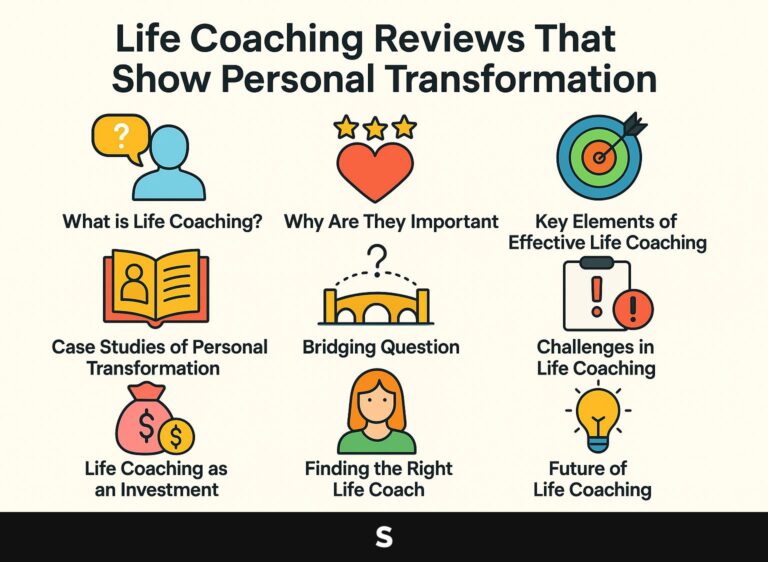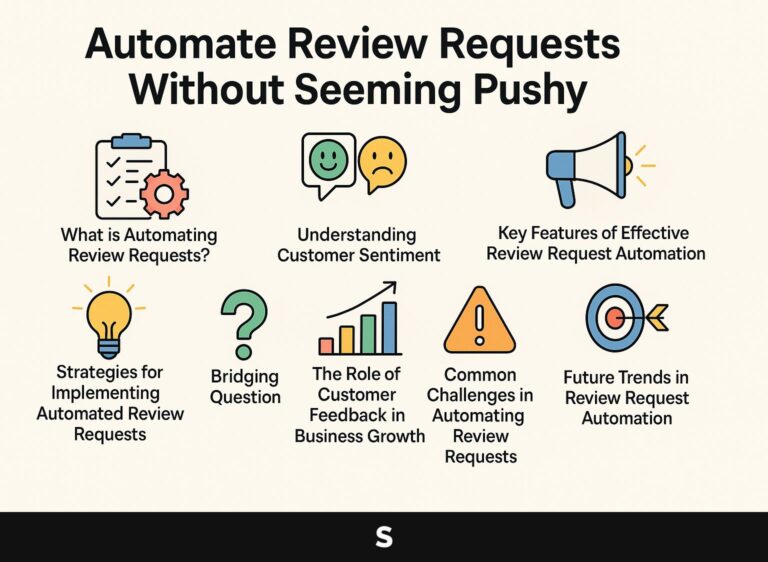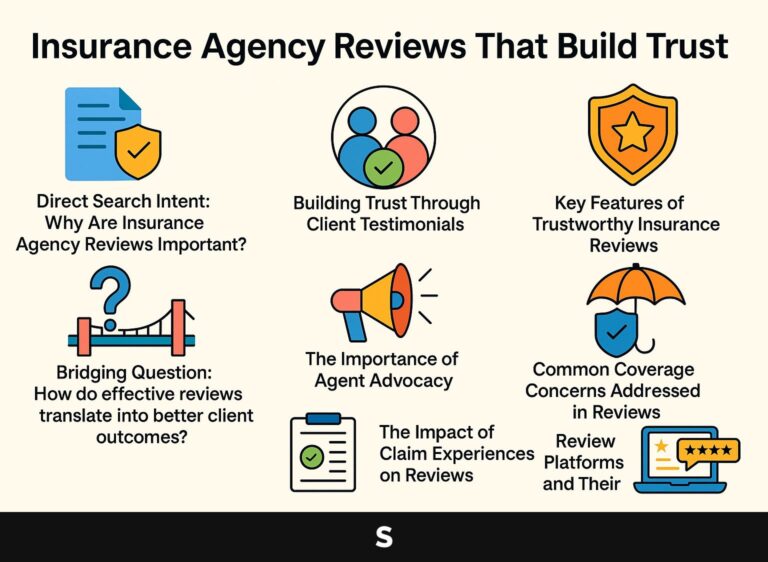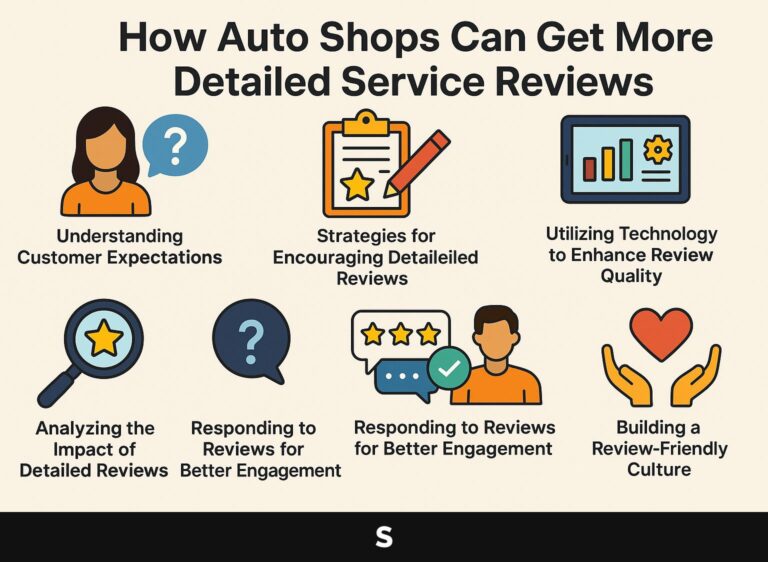Get Authentic Testimonials That Don’t Sound Fake
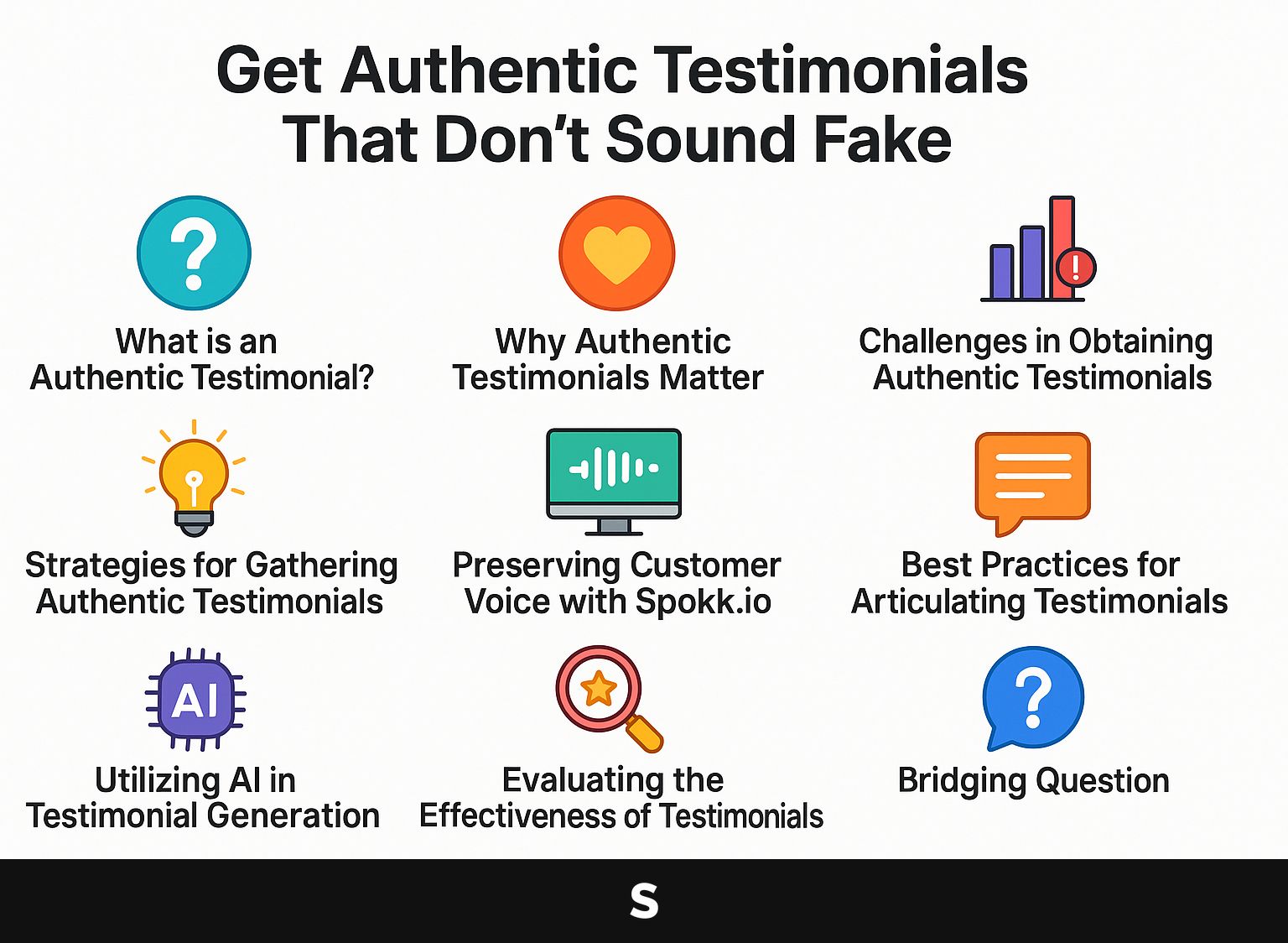
In the current market, real customer reviews are important for affecting buying choices and increasing sales. However, many businesses struggle to gather genuine feedback that resonates with potential customers. That’s where Spokk.io comes in. By enhancing real customer words while preserving their unique voice and sentiment, Spokk.io provides social proof that sounds natural and credible. This article will show you ways to get real testimonials that improve your sales support, making sure your reviews genuinely represent your customers’ experiences.
Key Takeaways:
- What is an Authentic Testimonial?
- Why Authentic Testimonials Matter
- Challenges in Obtaining Authentic Testimonials
- Strategies for Gathering Authentic Testimonials
- Preserving Customer Voice with Spokk.io
- Best Practices for Articulating Testimonials
- Utilizing AI in Testimonial Generation
- Evaluating the Effectiveness of Testimonials
- Bridging Question
- Social Proof: Why It Matters
- Contextual Vector: Legal Considerations
- Using Testimonials in Marketing
- Vector in Context: Continuous Improvement
- Frequently Asked Questions
- What is the importance of getting authentic testimonials?
- How can Spokk.io help me get authentic testimonials?
- Why do fake testimonials harm my brand?
- What does Spokk.io do to make my testimonials sound real?
- Can I still use testimonials if they have been edited by Spokk.io?
- Why is it important to maintain the customer’s voice and sentiment in testimonials?
What is an Authentic Testimonial?
A real testimonial is a true statement from a buyer showing their happiness with a product or service, which is important for gaining trust and affecting potential buyers.
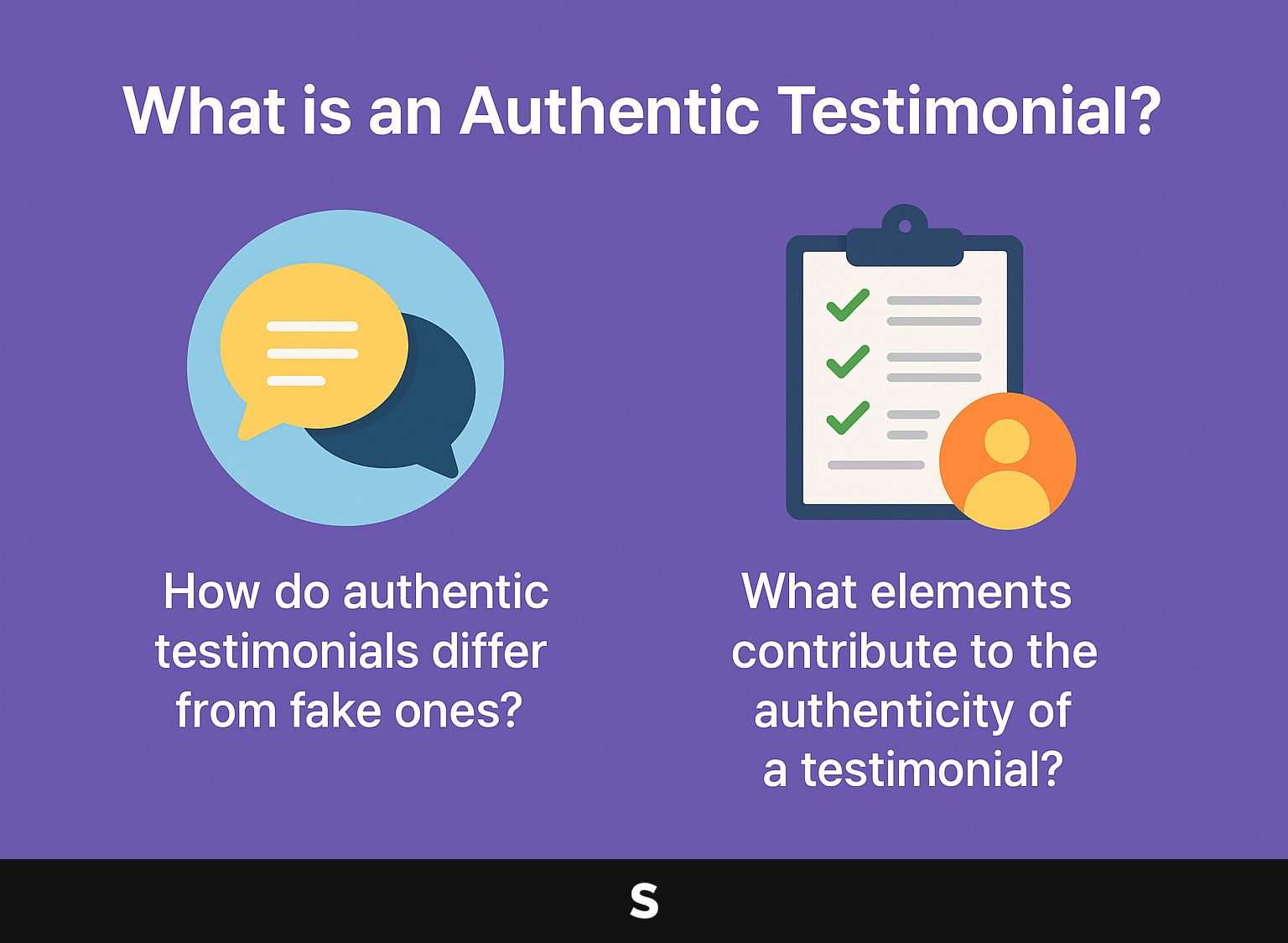
How do authentic testimonials differ from fake ones?
Authentic testimonials typically reflect real customer experiences, while fake ones often lack specific details, emotional resonance, and can be overly polished, raising red flags for consumers.
To make testimonials more genuine, ask customers to share detailed results or experiences. For example, instead of saying, ‘This product is great,’ ask them to detail how it solved a particular problem or improved their workflow.
Think about including video testimonials, which make it more personal and help build trust. Tools like Loom can help customers easily record their thoughts.
Include testimonials from people of different backgrounds to reach a wider audience.
What elements contribute to the authenticity of a testimonial?
Important parts like using particular customer stories, emotional words, and a setting that people can relate to make a testimonial feel real.
To create interesting customer stories, focus on three key parts.
- First, include a detailed customer experience-describe the problem they faced and how your product provided a solution. For instance, instead of saying ‘great service,’ detail how your service reduced their workload by 50%.
- Second, invoke emotional language to connect with readers, such as expressing relief or joy. Make sure the situation is clear; include real names and places whenever possible.
Together, these parts build trust and strongly connect with those you want to reach.
Why Authentic Testimonials Matter
Real testimonials are important for building consumer trust since 79% of consumers say content made by users greatly affects their buying choices.
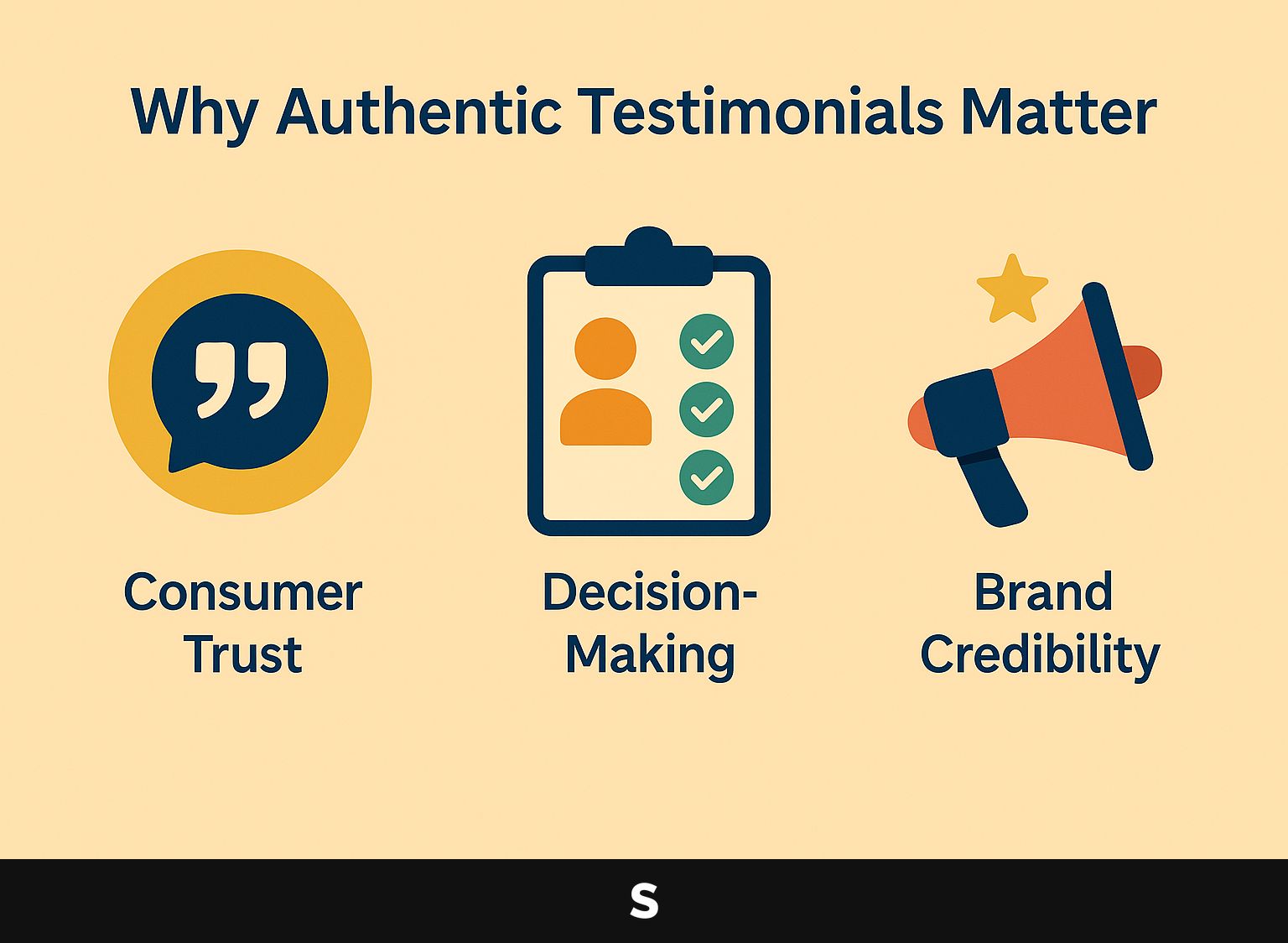
How do authentic testimonials impact consumer trust?
Authentic testimonials can increase consumer trust by showcasing real experiences, thereby acting as social proof that validates a brand’s claims.
Brands like Amazon and Airbnb use customer reviews to increase trust. According to a recent study, 79% of consumers trust online reviews as much as personal recommendations.
Incorporating authentic customer feedback on product pages can lead to a 14% increase in conversions. Tools like Trustpilot or Yotpo can help businesses collect and showcase these testimonials effectively.
By showcasing real opinions, brands make their operations more open and create a strong bond with potential customers.
How do testimonials influence decision-making?
Testimonials often serve as a decisive factor in the buying process, with 72% of consumers saying positive reviews increase their trust in a business.
This important effect highlights the importance of showing customer feedback in a clear way.
Showing star ratings on product pages can greatly increase trust. Using platforms like Trustpilot or Google Reviews enables real-time updates and authentic user comments.
A business could use testimonials in social media campaigns by including photos or video clips from happy customers.
When businesses ask customers to talk about their experiences, they can build trust and may see a 30% rise in conversion rates, showing the clear advantages of effectively using testimonials.
How can testimonials improve brand trust?
By sharing genuine testimonials, brands can build trust, as they offer real-life recommendations that potential customers can connect with.
To use testimonials well, brands should collect different viewpoints that connect with various types of customers. For instance, a skincare company might feature reviews from a teenager, a middle-aged user, and someone with sensitive skin.
Tools like Trustpilot and Yotpo facilitate the collection and display of testimonials. Campaigns like Airbnb’s “Host Stories” highlight real user experiences, attracting potential clients by showcasing relatable narratives.
By including stories that reach different groups of people, brands change their message and attract more interest, building trust and connection with a larger audience.
Challenges in Obtaining Authentic Testimonials
Businesses often struggle to get real feedback in testimonials because of common mistakes that can affect their honesty.
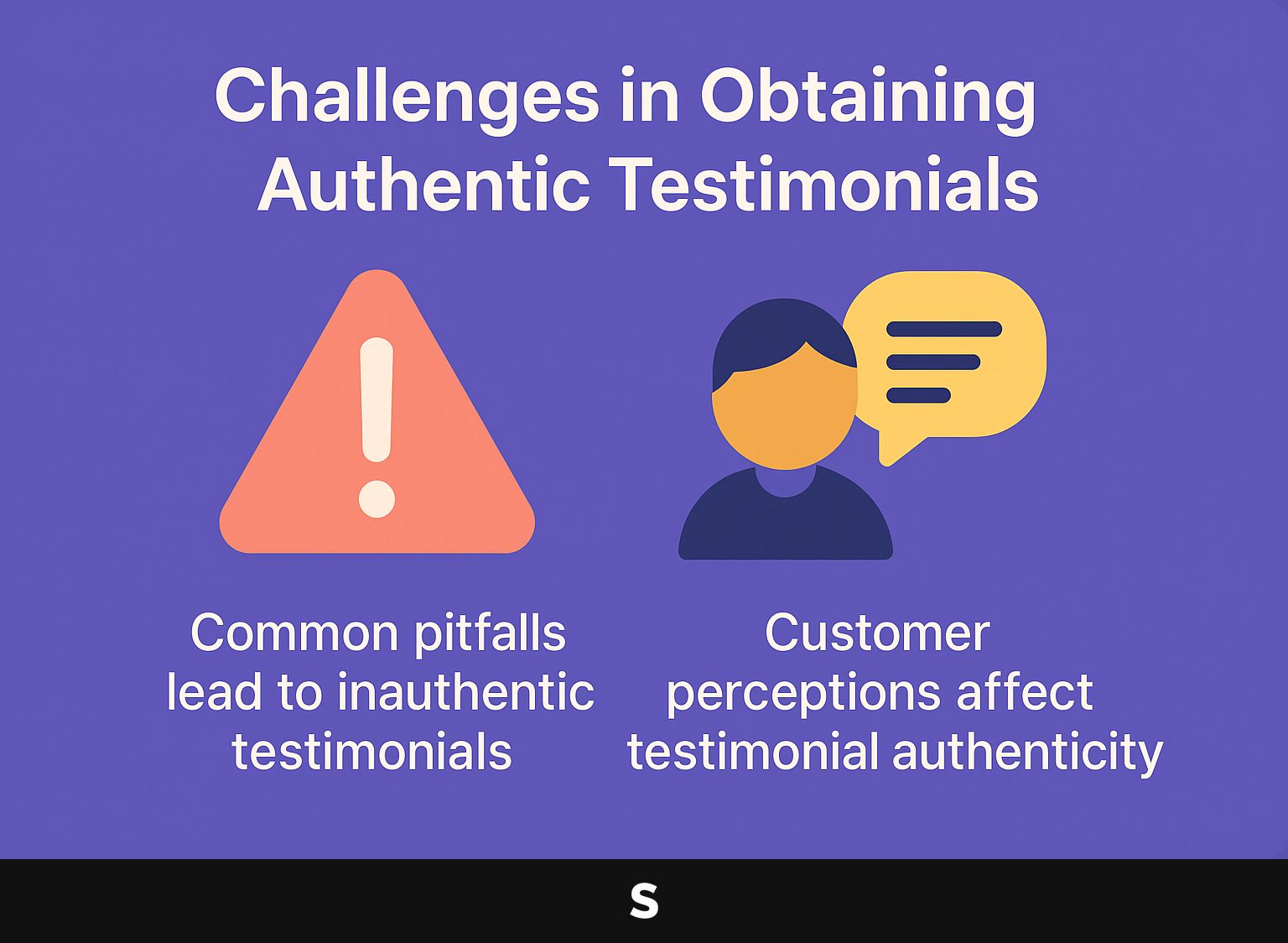
What common pitfalls lead to inauthentic testimonials?
Common pitfalls such as leading questions, pressure on customers, and lack of follow-up can result in inauthentic testimonials that fail to represent true customer sentiment.
To make testimonials feel more genuine, use open-ended questions like, ‘How was your experience with our product?’ This way, you don’t push customers too hard. Instead, ask them to share their thoughts willingly, maybe through an email or a special feedback page.
Implement a follow-up strategy: check in with customers post-purchase and remind them they can share their thoughts anytime.
These methods encourage real responses and help create a positive connection with your audience, which builds trust.
How do customer perceptions affect testimonial authenticity?
Customer perceptions heavily influence how testimonials are viewed; if a customer feels pressured or coerced, the resulting testimonial may lack sincerity.
This perceived authenticity is critical; for instance, a survey by BrightLocal found that 79% of consumers trust online reviews as much as personal recommendations.
In a case study involving a tech company, clients who were approached organically provided more positive feedback. When clients were incentivized for reviews, their testimonials often included caveats about feeling pressured.
Using tools like Trustpilot or Feefo can help solicit genuine feedback, as they emphasize voluntary participation. Creating a welcoming space for reviews builds trust and improves reputation.
Strategies for Gathering Authentic Testimonials
Using successful methods to collect genuine testimonials can greatly improve the quality of feedback from customers. Once you’ve gathered this feedback, it’s crucial to understand how to effectively manage and utilize it. Our guide to mastering customer feedback management provides essential strategies to ensure that customer insights are applied effectively.
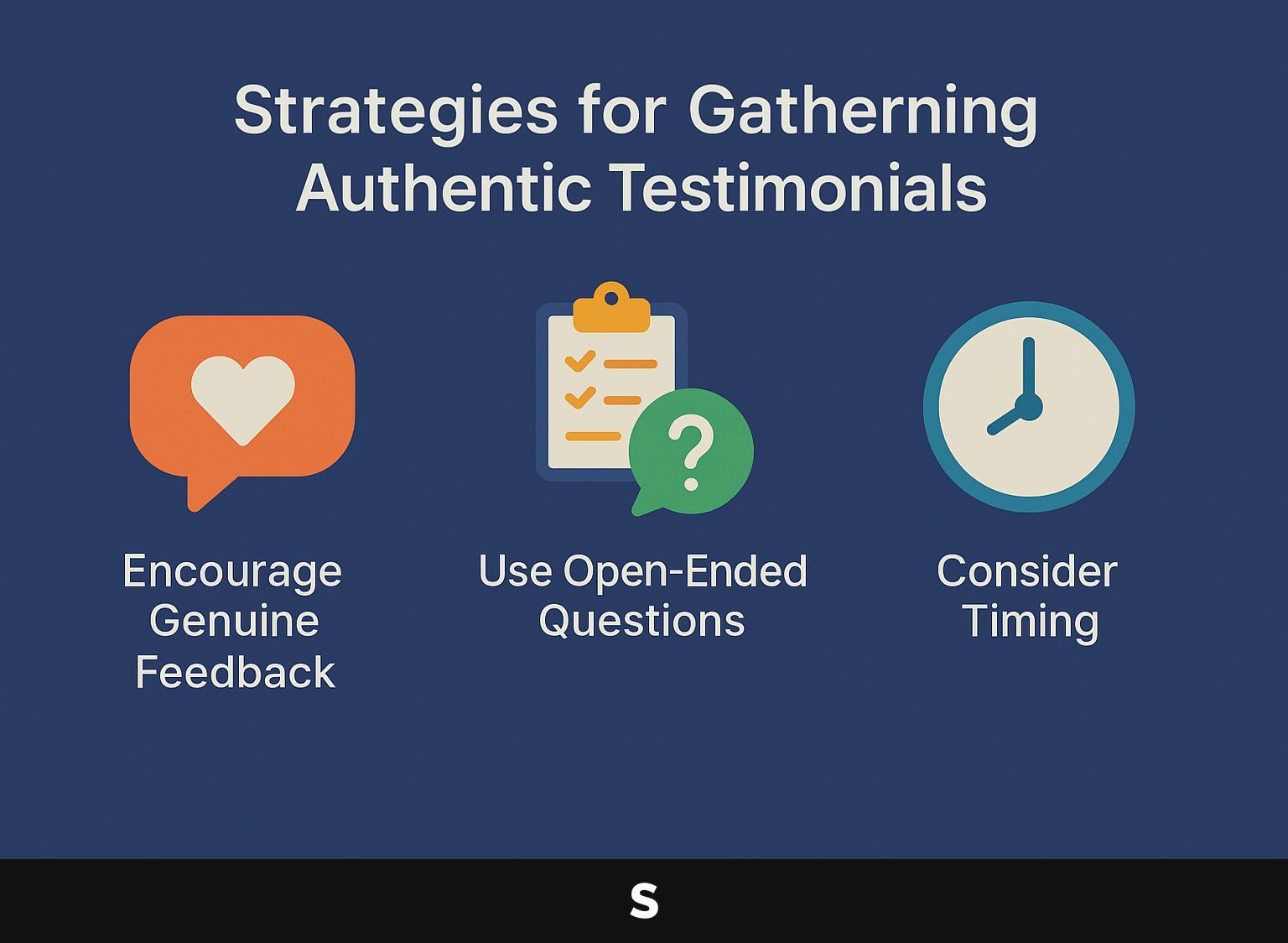
What techniques can be used to encourage genuine feedback?
Ask customers for feedback in a way that feels personal, explain why their opinions matter, and make it easy for them to share their thoughts.
To improve your method, try these practical steps:
- Timing Ask for feedback shortly after a positive experience, like completing a project or making a purchase.
- Incentivization can be effective; offering discounts or entry into a prize draw can motivate participation.
- Template Assistance helps customers articulate their thoughts; providing a structure can simplify the process for them.
- Showcasing Examples of existing testimonials increases credibility and encourages others to contribute.
Implementing these strategies can lead to a richer collection of authentic testimonials.
How can open-ended questions elicit more authentic responses?
Asking open-ended questions lets customers share their experiences and feelings openly, resulting in more genuine feedback and honest reviews.
To make open-ended questions work well, focus on prompts that encourage people to give detailed answers. For example, instead of asking, ‘Did you like the product?’, try ‘What features of the product did you find most beneficial and why?’. This invites a more detailed response.
You can ask, ‘Can you describe a specific situation where our service helped you?’ to gain context and personal stories. Using phrases like ‘How did you feel when…’ or ‘What changes did you notice after…?’ also help extract richer feedback, enhancing the quality of testimonials.
What role does timing play in collecting testimonials?
The timing of asking for testimonials can greatly affect how genuine the feedback is. Asking right after an interaction often leads to more detailed feedback.
To get the best feedback, ask for testimonials at important times in the customer experience. For example, soon after a purchase, customers are most engaged and can easily recall their experience.
Similarly, after providing exceptional customer support, reaching out can capture their satisfaction while it’s fresh. To smoothly handle requests, use automatic emails or feedback forms that are sent at these times.
Tools like SurveyMonkey or Typeform make it easy to collect helpful testimonials from customers, encouraging them to share their positive experiences.
Preserving Customer Voice with Spokk.io
Spokk.io makes customer feedback better by keeping what customers originally express, while explaining their comments more clearly and thoroughly.
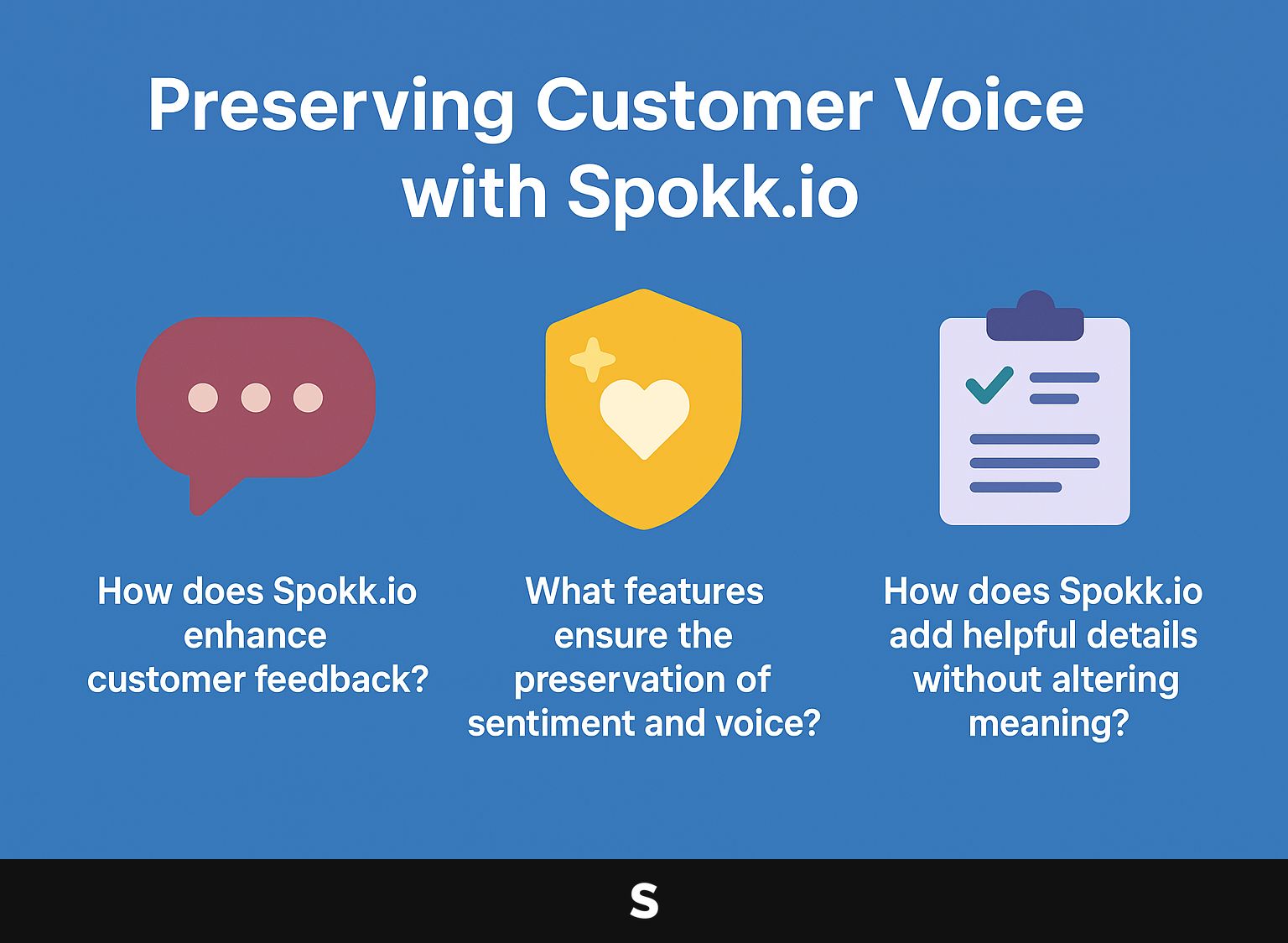
How does Spokk.io improve customer feedback?
Spokk.io employs advanced AI technology to articulate customer feedback in a way that retains the essence of their original words and emotions.
Spokk.io uses natural language processing to turn unorganized feedback into organized information. For example, it analyzes sentiment to gauge customer satisfaction levels, categorizing feedback into positive, neutral, and negative tones.
This helps brands quickly grasp current feelings. Spokk.io uses machine learning algorithms to identify recurring themes and keywords, helping businesses pinpoint specific areas for improvement.
With these tools, companies can create practical plans that genuinely show what customers want, strengthening connections and making smarter decisions.
What elements help maintain emotion and tone?
Important features like sentiment tagging and grasping the context help Spokk.io keep the emotional tone and purpose of customer feedback.
Sentiment tagging works by categorizing feedback into positive, neutral, or negative sentiments, which helps businesses quickly assess overall customer mood.
Looking at the words around a sentence helps find hidden feelings. For instance, the sentence “I love the product, but the service could improve” is both praise and criticism.
Together, these features help brands reply carefully, building trust and honesty in how they interact with customers.
How does Spokk.io add helpful details without altering meaning?
Spokk.io improves testimonials by including relevant details that add depth to the story without changing its original purpose or meaning.
For instance, after a customer shares their success story, Spokk.io might include data points like percentage increases in sales or customer engagement metrics. This confirms the testimonial and helps potential clients see the real advantages.
The platform might showcase user demographics or specific use cases that align with target audiences, such as a startup using a product to achieve a milestone. This storytelling approach stays true to the facts while giving a complete view of how the product affects users.
Best Practices for Articulating Testimonials
Sharing testimonials clearly helps make them more influential and connects with potential customers.
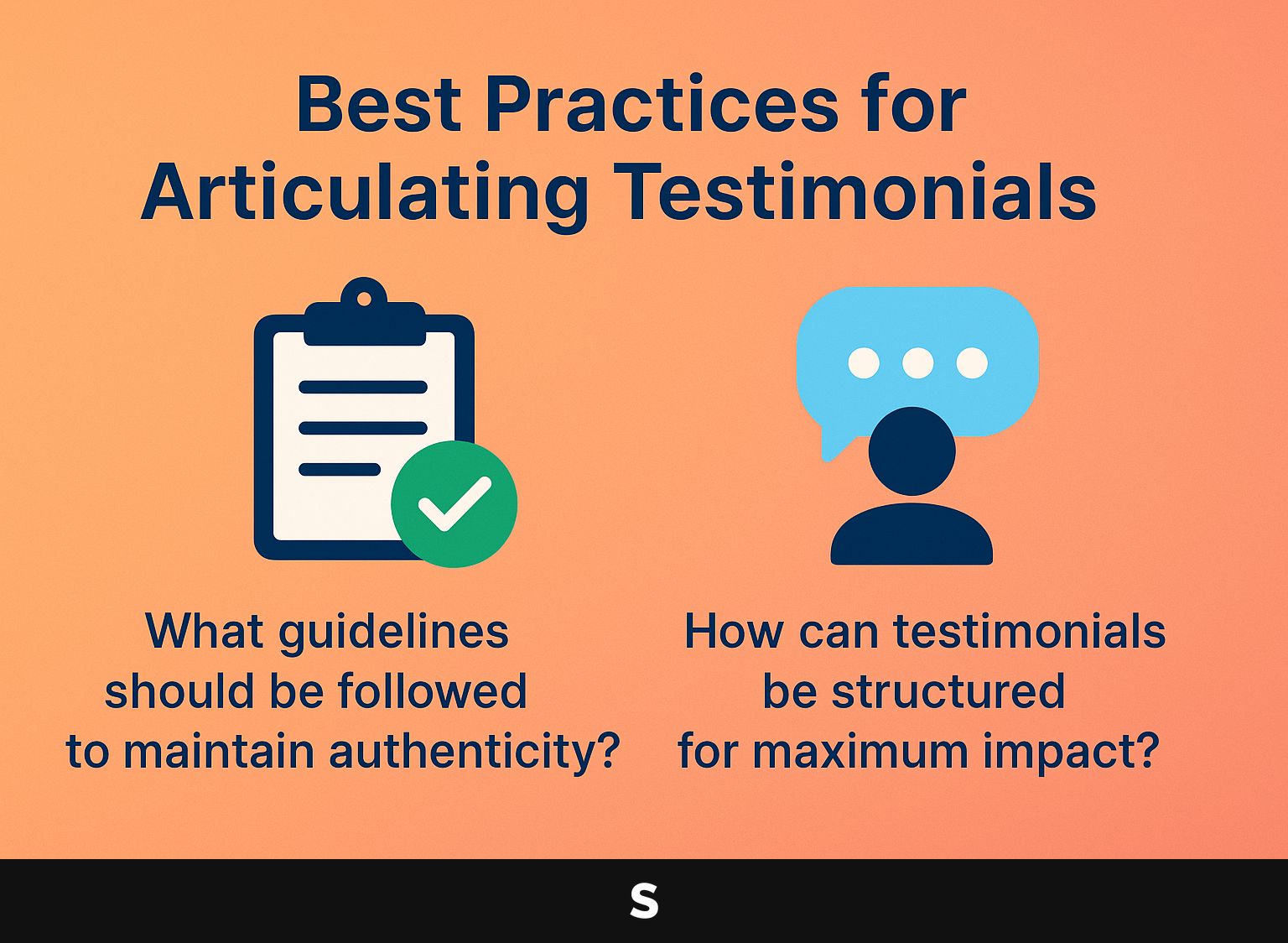
What guidelines should be followed to maintain authenticity?
Maintaining authenticity in testimonials involves following specific guidelines such as using customer language, avoiding jargon, and ensuring personal anecdotes are included.
To write effective testimonials, follow these guidelines and avoid common mistakes.
- Do use relatable language that reflects the customer’s experience, illustrating how your product or service solved a specific problem. For instance, instead of saying “This product is effective,” a more authentic statement could be, “After using this product for a month, my back pain significantly reduced, allowing me to enjoy daily walks again.”
- Don’t exaggerate claims or fabricate experiences, as this can erode trust.
Clear and truthful reviews relate better with potential customers and create trust.
How can testimonials be structured for maximum impact?
Organizing testimonials to emphasize main advantages and feelings can greatly improve their impact in advertising.
An effective testimonial structure often involves three components: the problem, the solution, and the benefit.
For example, a customer might state, “Before using [Product X], my workflows were chaotic and unorganized. “After using it, I noticed my task completion rate doubled, and I saved two hours each day.” This example highlights a frequent problem and directly outlines the improvement, making it more useful.
Use platforms like Trustpilot or Google Reviews to collect real feedback that shows true customer experiences.
Utilizing AI in Testimonial Generation
AI tools introduce new ways to create and improve testimonials, making the process faster while keeping them genuine. To enhance your understanding of crafting impactful testimonials, consider exploring our guide on mastering positive review examples.

What advantages does AI offer in enhancing testimonials?
AI can improve testimonials by quickly reviewing and combining customer feedback, allowing businesses to create effective testimonials in large quantities.
For example, brands like Nike use AI tools like Textio to adjust their messages based on how customers feel, which helps them make more relatable and interesting stories.
Platforms like Yotpo use AI to collect and examine customer reviews, pointing out main ideas and phrases that appeal to people.
When companies use technology for this task, they save time and make sure their testimonials are authentic and suited to their needs. This draws in new customers and significantly improves their marketing outcomes.
How does AI maintain the natural flow of customer language?
Advanced AI models use natural language processing (NLP) techniques to make sure that the generated testimonials sound like real customer language.
For instance, tools like OpenAI’s GPT or Google’s BERT are designed to analyze patterns in language, enabling them to mimic authentic customer phrases effectively. Businesses frequently use these models to create testimonials that connect with potential clients.
NLP can help in sentiment analysis, gauging customer feelings from feedback, and adjusting generated content accordingly.
When using these models, companies should use a wide variety of real testimonials to train the AI. This makes the results more relevant and trustworthy.
Evaluating the Effectiveness of Testimonials
Checking how well testimonials work is important for knowing how they affect what customers do and planning marketing strategies.
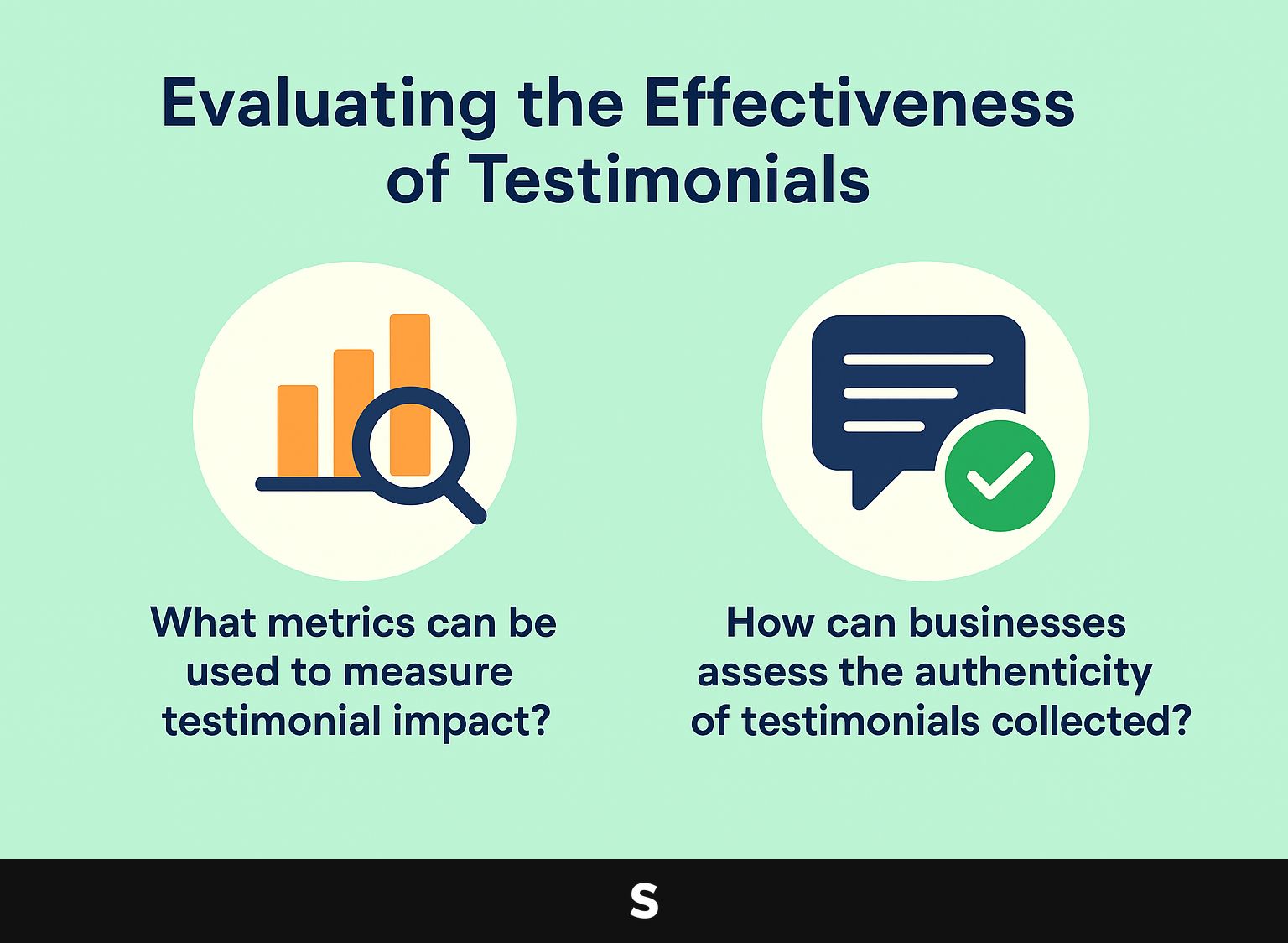
What metrics can be used to measure testimonial impact?
Metrics such as conversion rates, engagement rates, and customer satisfaction can effectively gauge the impact of testimonials on consumer decisions.
To find out how many people take an action like signing up for a newsletter or buying something after seeing testimonials, calculate the percentage of visitors who do this.
Engagement rates can be measured by looking at social media interactions or comments on testimonial posts, showing how interesting your audience thinks they are.
Customer satisfaction can be checked using follow-up surveys or Net Promoter Scores (NPS). These methods help understand how reviews affect buyers’ overall opinions.
For example, a business that added customer testimonials to its landing page saw a 20% increase in conversions within a month.
How can businesses assess the authenticity of testimonials collected?
Businesses can assess the authenticity of testimonials by verifying customer identities, analyzing sentiment consistency, and cross-referencing with other feedback sources.
- First, ask the customer for their order confirmation or other information that verifies they are genuine buyers.
- Next, analyze the sentiment of testimonials for consistency; a sudden, dramatic shift in tone may indicate manipulation. Compare testimonials against reviews on independent platforms like Yelp or Trustpilot to check for discrepancies.
- Tools like Phrazor or MonkeyLearn can examine customer emotions, ensuring feedback is authentic.
Bridging Question
To keep customer feedback authentic, you need a clear plan for gathering and managing reviews effectively.
How can businesses keep customer feedback honest over time?
Regularly checking in with customers, asking for feedback from various sources, and adjusting to what customers want can help businesses keep their testimonials genuine over time.
To make customer feedback more genuine, businesses should use a structured method.
Start by using tools like SurveyMonkey for anonymous feedback, allowing honest responses. Use CRM tools like HubSpot to regularly plan follow-up interactions.
Get a range of opinions by sending specific surveys to different groups of customers. Analyze trends with sentiment analysis tools like Qualtrics, adjusting your strategies accordingly.
This repeated process builds trust and shows that we listen, leading to better customer feedback.
Social Proof: Why It Matters
Customer reviews are an important way to show a brand’s trustworthiness by sharing real customer experiences, which can impact buyer decisions.
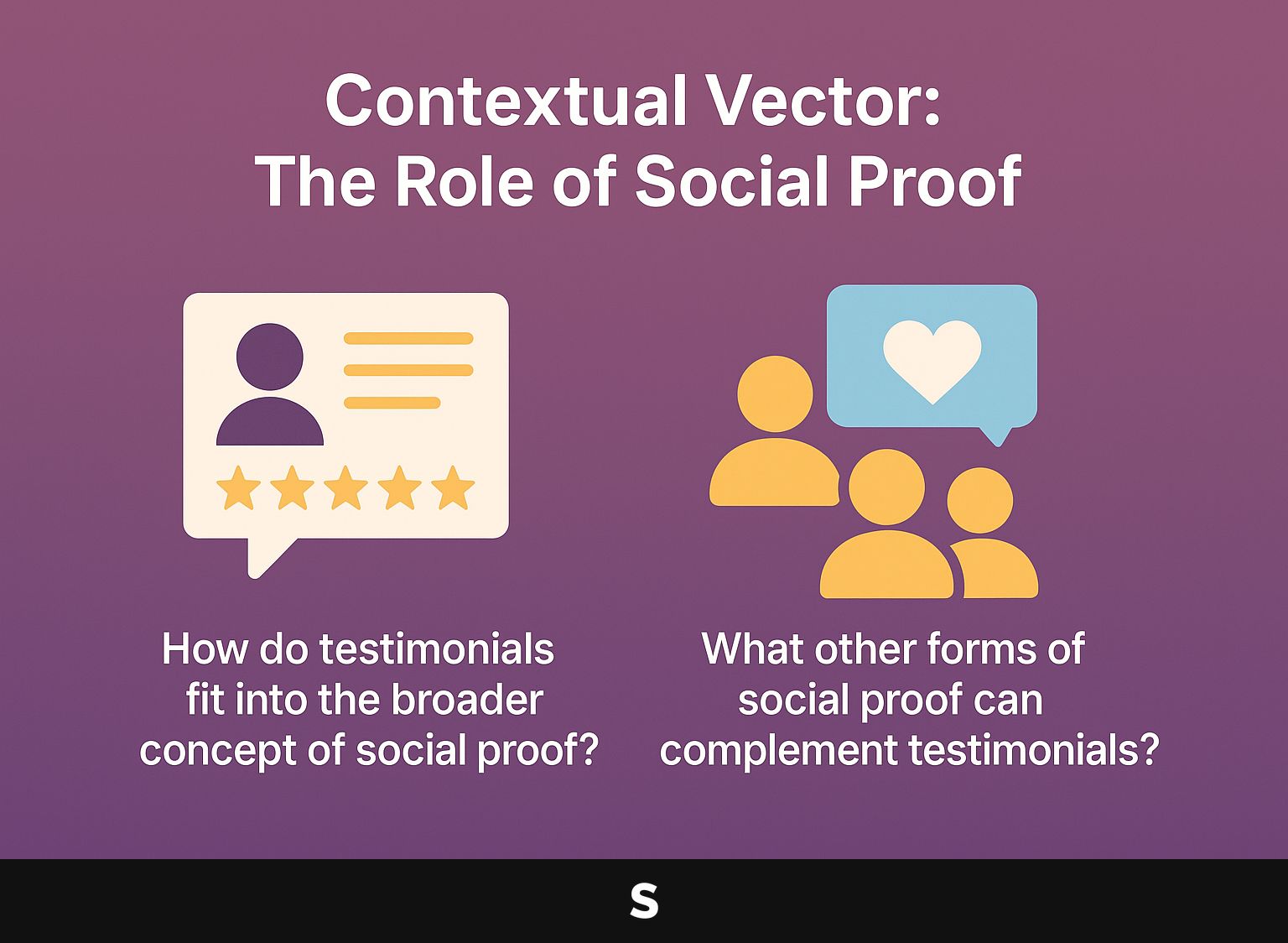
Testimonials serve as a powerful component of social proof, providing potential customers with confidence in their purchasing decisions through shared experiences.
For instance, placing customer quotes prominently on product pages can increase conversion rates. Consider incorporating short, impactful testimonials like “This tool saved me hours each week!” alongside images of happy users.
Tools such as Trustpilot or Yotpo allow businesses to collect and showcase verified reviews seamlessly. Video testimonials can be very powerful; a happy customer talking about their experience on a social platform often connects better with others than just written words.
By carefully placing these testimonials in marketing materials, businesses can build trust and increase sales.
Other types of social proof, like online reviews, case studies, influencer recommendations, and social media interactions, work together with testimonials to strengthen brand credibility.
Adding these parts to your marketing plan makes it feel more genuine. For instance, showcasing online reviews alongside customer testimonials on your website provides potential clients with a broader sense of user satisfaction.
Providing examples of particular cases can show positive outcomes, clearly highlighting your advantages. Getting influencers to talk about their experiences helps you connect with more people and build credibility with their followers.
To get the most impact, use social media to regularly share interesting content that includes these types of social proof, creating an active conversation around your brand.
Contextual Vector: Legal Considerations
Knowing legal rules for using testimonials is important to shield businesses from possible backlash and to comply with advertising laws.
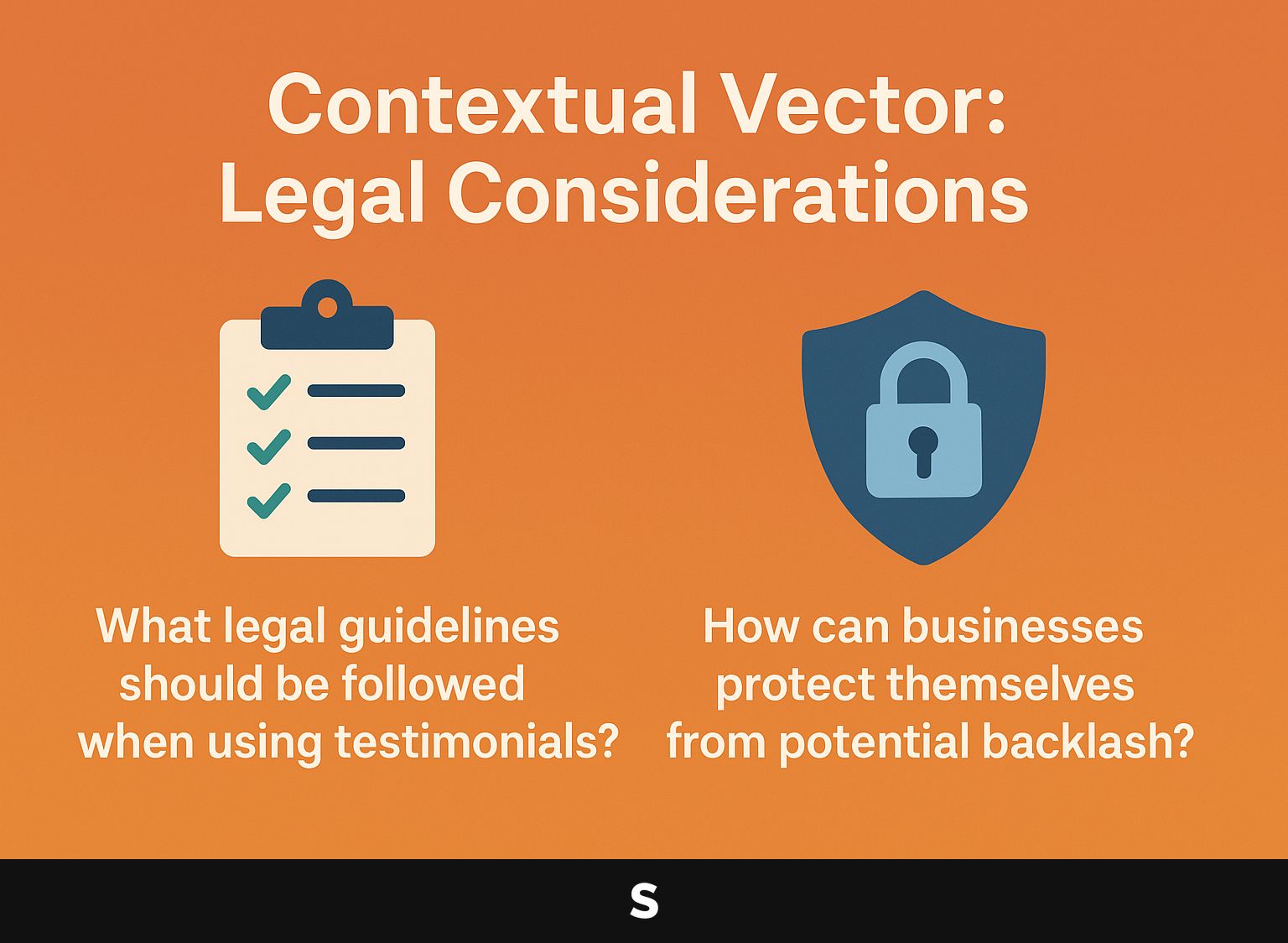
What legal guidelines should be followed when using testimonials?
Businesses must adhere to legal guidelines such as ensuring transparency, not fabricating testimonials, and disclosing any material connections to the reviewer.
Businesses should check that testimonials reflect common experiences to meet FTC rules.
For example, if you display customer reviews, make sure they show different results and not just the best ones. If a reviewer received compensation, this must be clearly stated, such as adding a note like “Reviewer received a discount for their feedback.”
Utilizing tools like the FTC’s Endorsement Guides can help clarify these requirements further, ensuring that your testimonials maintain authenticity and legality while building trust with potential customers.
How can businesses protect themselves from potential backlash?
To reduce possible negative feedback, businesses should take steps like checking testimonials, being open about operations, and quickly addressing customer issues.
Plus these practices, businesses can proactively engage with customers by encouraging feedback directly after a purchase. Utilizing tools like SurveyMonkey or Google Forms facilitates this process, allowing companies to address any issues before they escalate.
It’s also beneficial to publish testimonials in a way that clearly highlights their authenticity, such as using verified customer names or including photos. If there is a negative reaction, it’s important to reply quickly and honestly. Having a team to handle these situations can make sure that customer issues are dealt with consistently and thoughtfully.
Using Testimonials in Marketing
Adding customer reviews to marketing strategies can make them more effective, making them a key part of good brand communication. To fully harness this potential, businesses should consider the methodology in our ultimate guide to customer feedback strategy for comprehensive insights.

What are effective ways to showcase testimonials in campaigns?
Displaying testimonials with videos, quotes, and case studies can greatly increase their visibility and effectiveness in marketing efforts.
For instance, video testimonials allow potential customers to see and hear real experiences, creating an authentic connection. Websites like Vimeo or YouTube can store these videos, allowing them to be shared on social media.
Written quotes give clear messages; show them clearly on your website or in brochures. Case studies provide detailed examples and show results using specific numbers.
By using tools like Canva for images or HubSpot for organized content, you can create stories that connect with your audience and establish trust.
How can testimonials be used across different marketing channels?
Utilizing testimonials across multiple marketing channels, including social media, email campaigns, and websites, maximizes their reach and effectiveness.
To use testimonials well, display them on your website’s homepage so visitors see them right away. Share them in social media posts to encourage interaction.
In email campaigns, include a powerful quote from a customer with a direct link to your product page.
For video testimonials, you can use platforms like Vidyard or Loom to record real customer experiences, making them more relatable.
Use tools like Yotpo to collect and show user reviews easily, creating a feedback loop that can build trust across all channels.
Vector in Context: Continuous Improvement
Consistently improving how we gather testimonials helps keep customer feedback genuine and meaningful.
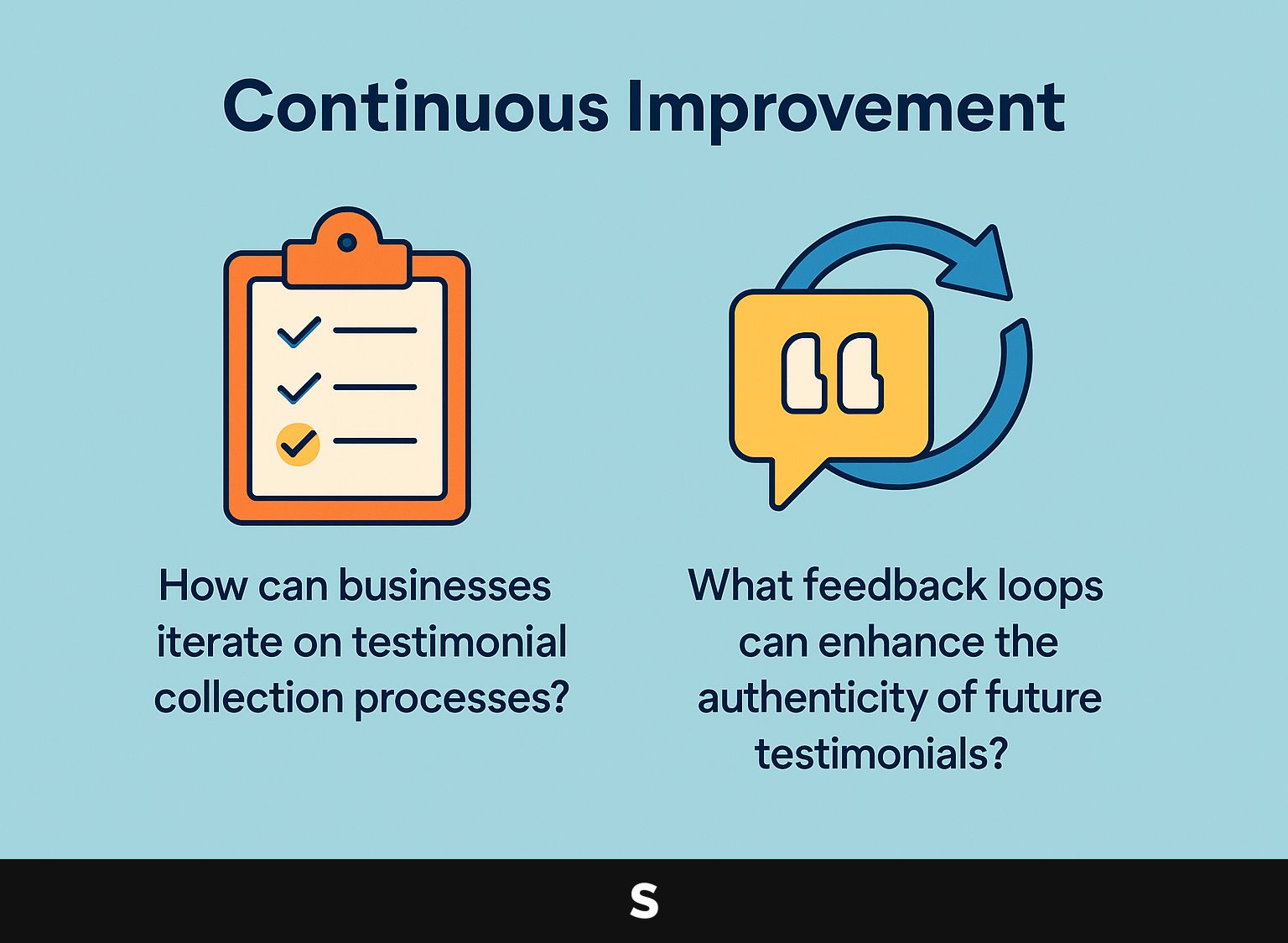
How can businesses improve their methods for gathering testimonials?
Businesses can improve how they gather testimonials by reviewing past feedback, changing their approach, and using new tools to make reviews more genuine.
Begin by collecting feedback from current reviews. Identify common themes or areas for improvement.
Then, consider using tools like Typeform for engaging surveys, which can encourage clients to share detailed experiences. Implement follow-up processes to reach out personally, enhancing response rates.
Use social media platforms to gather real-time feedback, building a system to collect testimonials. Adjust your strategy based on seasonal trends or new product releases, ensuring your methods remain effective and efficient.
What feedback methods can help make testimonials more genuine in the future?
Regularly collecting customer opinions helps ensure that future reviews are truthful and applicable.
To implement effective feedback loops, consider tools like Typeform for surveys, which allows for customizable questions and real-time analytics.
Incorporating regular check-ins via email can help collect feedback on recent interactions. Also, using Google Forms for surveys after a purchase gathers feedback quickly and easily.
Set up a regular plan to check this data; monthly review meetings let you change your strategies based on customer feedback.
Using platforms like Trustpilot can help you keep track of current reviews and change your approach to testimonials as needed.
Frequently Asked Questions
What is the importance of getting authentic testimonials?
Real customer reviews are important because they offer honest opinions, which helps people trust and believe in your brand.
How can Spokk.io help me get authentic testimonials?
Spokk.io uses AI to improve real customer words, keeping their tone and emotions while providing useful information. This keeps your reviews genuine and makes them sound real.
Why do fake testimonials harm my brand?
Fake testimonials can damage your brand’s reputation and trustworthiness, leading to a decrease in sales and potential legal consequences. It’s important to only use genuine testimonials.
What does Spokk.io do to make my testimonials sound real?
Spokk.io’s AI technology improves real customer feedback, making sure the testimonial stays genuine and doesn’t seem fake or too promotional.
Can I still use testimonials if they have been edited by Spokk.io?
Absolutely! Spokk.io’s AI improves the customer’s original words, and the testimonial still comes from real feedback. This keeps your testimonials genuine and reliable.
Why is it important to maintain the customer’s voice and sentiment in testimonials?
Maintaining the customer’s voice and sentiment in testimonials helps to keep them genuine and relatable to potential customers. It also shows that you value your customers’ opinions and experiences.
